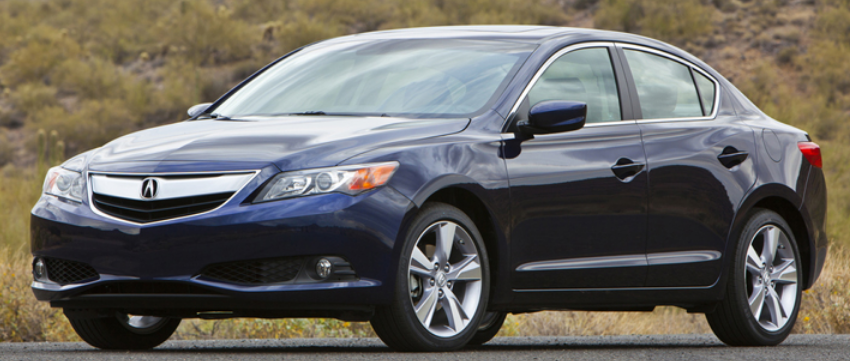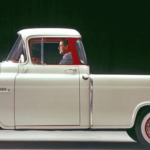
Note: This report supplements Consumer Guide Automotive’s full report on the 2013 Acura ILX, a premium-compact sedan that starts at $25,900.
Test car came equipped with: no options. The Tech model is priced at $32,295, including an $895 destination charge. Like parent Honda, Acura prices option packages as separate models.
Powertrain: 150-horsepower 2.0-liter 4-cylinder engine, 5-speed automatic transmission, front-wheel drive.
Acceleration: This is the only ILX I’ve driven so far. I had no opportunity to time it, but Acura claims 0-60 mph takes 9.6 seconds, and that feels about right to me also. The 2.0-liter ILX gets off the line with decent verve, but though my colleagues say the 5-speed automatic “kicks down quickly for more passing power,” I can’t agree. This car almost always requires full throttle for decent mid-range passing punch. You might do a little better—and have more fun—by using the steering-wheel shift paddles, which give temporary manual override in Drive or permanent override in Sport mode. It’s a little odd, though, that the shifter has no separate manual gate. In all, the 2.0-liter ILX gets around well for having only 150 horsepower and 140 pound-feet of torque, both of which peak at fairly high engine speeds (6500 and 4300 rpm, respectively). Too bad it’s saddled with only a 5-speed automatic instead of a 6-speeder like most rivals now have. I detect more than a faint whiff of cost-cutting here.
Fuel Economy: I averaged 28.4 mpg in a fairly even mix of Phoenix-area city/freeway driving, which is darn close to the EPA’s 28-mpg combined estimate. The gummint’s city/highway numbers are 24/35. (Note: I live and work in Phoenix, but did not participate in the media preview held in this area.)
Ride Quality: Phoenix-area pavement is mostly smoother than what you find around Chicago and other northern regions. This test car came on P215/45R17-87V Michelin Pilot HX MXM4 tires. It ironed out most bumps and ruts pretty well, especially considering its size and weight, but it’s less effective on patchy and washboard surfaces.
Steering/handling/braking: The steering and suspension feel a little mushy, as if they were operating through big rubber isolators. The ILX is pleasant and predictable in routine driving, and would doubtless deal well with twisty backroads, but its handling somehow lacks the immediacy and clarity of Acura’s own (slightly larger) TSX.
Quietness: I found tire noise the big bugaboo; it’s constant and borderline annoying except on glassy asphalt. The little 2.0-liter four generally sounds nice across its rpm range, but it never fades into the background, not least because the “low” gearing requires around 3000 rpm or so just to maintain 70 mph on the flat. Though the engine is quite happy at lofty revs, the ILX does not have the relaxed cruising gait one associates with a premium-brand car, even a small one.
2016 Acura ILX: Enhanced with Eight Speeds
Controls: I don’t find the control layout all that user-friendly, but it’s OK, even though it’s stubbornly Acura/Honda in some respects. For example, the climate control settings still display on a narrow strip that’s hard to read, and the controls themselves sit too low for easiest use while driving. Honda/Acura has used setups like this for years, and I wish they’d come up with something better. The same goes for the steering-wheel tabs for the trip-computer display between the main dials. The labeling still confuses me, and I’m probably not the only one. On the plus side, the audio system is pretty easy to use, and the dashboard screen is large, bright, and refreshingly legible.
Details: Yes, the ILX has “many padded surfaces,” and the two-toning is nice, but there’s no luxury-brand richness or art here; witness the unconvincing metal-look plastic dash trim. Other plastic panels are barely better than what you get in a Civic. Again I detect a whiff of cost-cutting.
Room/comfort (front): I noted the absence of a power passenger seat. It’s unavailable in any ILX, and that suggests more cost-cutting in this car’s conception. I’ll also add that a fairly low stance makes entry/exit a bit arduous for taller and/or less-limber folks.
Room/comfort (rear): I’d say the ILX is tight here in every dimension except for maybe pre-growth-spurt adolescents. It’s not exactly a “crampact,” but it’s close.
Cargo room: Seat backs? On my tester the rear-seat backrest was one-piece—another cheap-out legacy of the Civic and, in my view, even more of a drawback for cargo-carrying than the awkward load-floor step it creates when dropped. Other gripes: The trunk opening is mail-slot narrow, and the door map pockets are too small to be very useful.
CP Says . . . For all its many faults, I kind of like the ILX. It drives with an eager yet somehow mellow feel that many buyers will appreciate, and it’s the right size for the urban jungle. That said, its Civic origins are not that well-disguised, and Acura lacks true premium-brand status, so why pretend when a similar Civic EX-L or Si sedan goes for thousands less? About all you’d be giving up is some extra interior poshness, and that’s easy for me to accept, given such a big price difference. But actually, if you want a compact Acura sedan, get a Euro-Accord-based TSX before it’s discontinued. It’s still in the lineup for 2013, and I find it a much more satisfying overall package than the marketing-motivated ILX.
2013 Acura ILX vs. 2012 Honda Civic: A Real-World Walkaround



